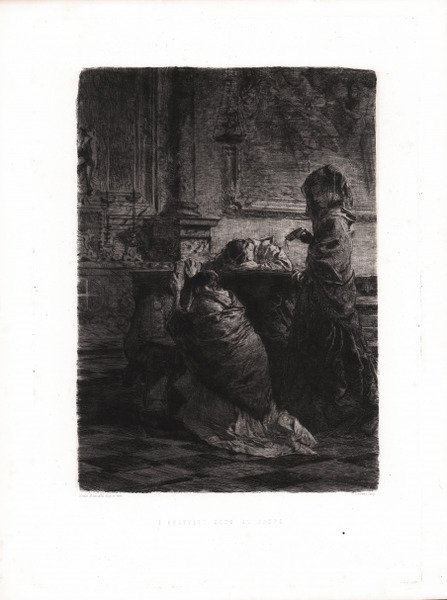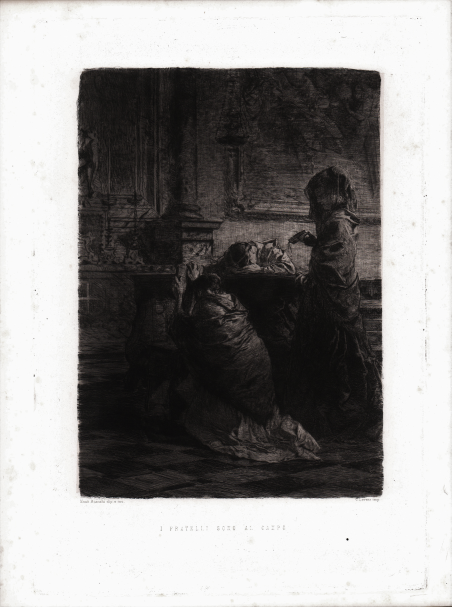Acquaforte e puntasecca stampata su carta coeva, in eccellente stato di conservazione. Incisione originale eseguita all'acquaforte su matrice di rame; in lastra, sotto la parte figurata, indicazione dell'artista in qualità di inventore ed esecutore, nome dello stampatore e titolo. L'opera, pregevole e coinvolgente per l'intenso effetto chiaroscurale, è tratta da una delle principali riviste d'arte italiane dell'epoca. L'immagine, riproducente un dipinto dello stesso Bianchi oggi conservato presso la Galleria d'arte moderna di Milano, rappresenta una scena ispirata agli ideali del Risorgimento: nella penombra di una chiesa, tre giovani donne pregano dinanzi all'altare per i fratelli che sono al campo di battaglia. ' ' Dipinto fortunato e celebratissimo anche per l'indovinata scelta del soggetto, ispirato alla terza guerra d'indipendenza combattuta per la liberazione di Venezia (1866), con chiari sottintesi risorgimentali e patriottici evocati fin dall'allusione al tricolore nelle vesti delle tre giovinette, fu tra le opere di Mosè Bianchi che maggiormente piacquero ai suoi primi critici. L'opera risente del giovanile soggiorno a Venezia, evidente nella cromia accesa e luminosa. La fama dei "Fratelli al campo" contribuì a moltiplicare le versioni, sotto forma di repliche, pseudo-bozzetti, varianti, in tecniche diverse, dall'olio all'acquarello, all'acquaforte. Influenzato dallo stile di Faruffini e Mariano Fortuny, Mosè Bianchi inizia con quadri storici di soggetto romantico, per volgersi poi al genere e al paesaggio. La sua pittura parve assai rinnovatrice, per l’attenzione data agli effetti atmosferici e per la tecnica spigliata, in realtà più vicina a quella del Fortuny che a quella degli impressionisti. Egli realizzò circa settanta opere incise all’interno delle quali riportò ciò che rappresentava nei dipinti ma l’attenzione non è più rivolta tanto al soggetto quanto ai giochi chiaroscurali. Etching and drypoint printed on contemporary paper, in excellent condition. Original etching executed on copper matrix; on the plate, under the image, indication of the artist as inventor and executor, name of the printer and title. The work, valuable and involving for the intense chiaroscuro effect, is taken from one of the main Italian art magazines of the time. The image, reproducing a painting by Bianchi himself, now preserved at the Gallery of Modern Art in Milan, represents a scene inspired by the ideals of the Risorgimento: in the half-light of a church, three young women pray before the altar for their brothers who are at the battlefield. ' This is a fortunate and celebrated painting, also because of the fortunate choice of the subject, inspired by the third war of independence fought for the liberation of Venice (1866), with clear Risorgimento and patriotic subtexts evoked by the allusion to the tricolor flag in the garments of the three young girls. It was one of the works by Mosè Bianchi that his critics liked the most. The work is influenced by his youthful stay in Venice, evident in the bright and vivid colors. The fame of the "Fratelli al campo" contributed to the multiplication of versions, in the form of replicas, pseudo-sketches, variants, in different techniques, from oil to watercolor, to etching. Influenced by the style of Faruffini and Mariano Fortuny, Moses Bianchi began with historical paintings of romantic subjects, then turned to the genre and landscape. His painting seemed very innovative, for the attention given to the atmospheric effects and for the easy technique, actually closer to that of Fortuny than to that of the impressionists. He made about seventy engraved works in which he reported what he represented in the paintings but the attention is no longer directed so much to the subject as to the chiaroscuro games. Cfr. Bibliografia Giubbini G., "L'acquaforte originale in Piemonte e in Liguria. 1860-1875", Genova 1976, p. 103 fig. 41; "Mosè Bianchi e il suo tempo", cat. della mostra, Milano 1987, p. 202 fig. 3.


Descubre cómo utilizar
Descubre cómo utilizar

